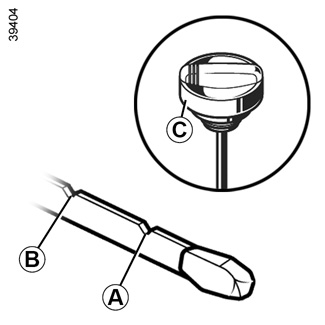ENGINE OIL LEVEL: general information

It is normal for an engine to use oil for lubrication and cooling of moving parts and it is normal to top up the level between oil changes.
However, contact your approved Dealer if more than 0.5 litres is being consumed every 600 miles (1,000 km) after the running in period.
Oil change frequency: check the oil level from time to time and certainly before any long journey to avoid the risk of damaging your engine.
Reading the oil level
The oil level should be read with the vehicle on level ground, after the engine has been switched off for some time.
The dipstick must be used to read the exact oil level and ensure that the maximum level is not exceeded (risk of engine damage). Refer to the following pages.
- Remove the dipstick and wipe with a clean, lint-free cloth;
- push the dipstick in as far as it will go (for vehicles equipped with a cap-type dipstick C, screw the cap in as far as it will go);
- take out the dipstick again;
- read the level: it should never go below the “min” A or above the “max” B.
Once the operation has been completed, ensure that the dipstick is pushed in as far as it will go or that the “cap-type dipstick” is completely screwed in.
In order to prevent splashback, it is recommended that a funnel be used when topping up/filling with oil.
Deactivate the Stop and Start function for any operation performed in the engine compartment.
Consult your approved Dealer at once if you notice an abnormal or repeated drop in any of the fluid levels.
Exceeding the maximum engine oil level
Under no circumstances must the maximum fill level B be exceeded: risk of damage to the engine and catalytic converter.
If the oil level exceeds the maximum level, do not start your vehicle and contact an approved Dealer.